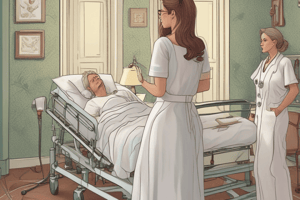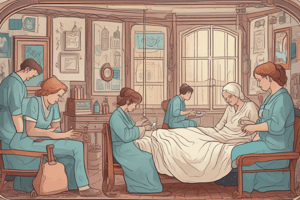Podcast
Questions and Answers
Nursing is only a science and not an art.
Nursing is only a science and not an art.
False (B)
What is nursing a combination of?
What is nursing a combination of?
Nursing is a combination of scientific knowledge, compassion, and respect for human dignity.
Nurses do not need to integrate science into their practice.
Nurses do not need to integrate science into their practice.
False (B)
What does caring practice involve?
What does caring practice involve?
According to Roach, what does competence involve in nursing?
According to Roach, what does competence involve in nursing?
What is the importance of self-care in nursing?
What is the importance of self-care in nursing?
According to the ANA Code of Ethics, what duties do nurses have?
According to the ANA Code of Ethics, what duties do nurses have?
What is communication in nursing?
What is communication in nursing?
What does therapeutic communication involve?
What does therapeutic communication involve?
What are the main components of the communication process?
What are the main components of the communication process?
What is verbal communication?
What is verbal communication?
Flashcards
Caring
Caring
Sharing deep and genuine concern about the welfare of another person.
Caring practice
Caring practice
Involves connection, mutual recognition, and involvement between nurse and client.
Purpose of nursing
Purpose of nursing
To know people and nurture them as individuals living and growing in caring.
Assumptions of nursing as caring
Assumptions of nursing as caring
Signup and view all the flashcards
Caring for self
Caring for self
Signup and view all the flashcards
Self-care
Self-care
Signup and view all the flashcards
Self-care definition
Self-care definition
Signup and view all the flashcards
Self-care benefits
Self-care benefits
Signup and view all the flashcards
Duties to oneself (Nurses)
Duties to oneself (Nurses)
Signup and view all the flashcards
Communication
Communication
Signup and view all the flashcards
Communication definition
Communication definition
Signup and view all the flashcards
Communication (Aristotle)
Communication (Aristotle)
Signup and view all the flashcards
Communication (Leagens)
Communication (Leagens)
Signup and view all the flashcards
Components of communication
Components of communication
Signup and view all the flashcards
Sender
Sender
Signup and view all the flashcards
Sender's role
Sender's role
Signup and view all the flashcards
Message
Message
Signup and view all the flashcards
Forms of a message
Forms of a message
Signup and view all the flashcards
Channels
Channels
Signup and view all the flashcards
Types of Channels
Types of Channels
Signup and view all the flashcards
Receiver
Receiver
Signup and view all the flashcards
Feedback
Feedback
Signup and view all the flashcards
Verbal Communication
Verbal Communication
Signup and view all the flashcards
Non-verbal communication
Non-verbal communication
Signup and view all the flashcards
Examples of non-verbal cues
Examples of non-verbal cues
Signup and view all the flashcards
Therapeutic communication
Therapeutic communication
Signup and view all the flashcards
Nurse's role in therapeutic communication
Nurse's role in therapeutic communication
Signup and view all the flashcards
Therapeutic techniques
Therapeutic techniques
Signup and view all the flashcards
Teaching-Learning Process
Teaching-Learning Process
Signup and view all the flashcards
Interaction in teaching-learning
Interaction in teaching-learning
Signup and view all the flashcards
Study Notes
- Nursing is both an art and a science
- Nursing combines scientific knowledge, compassion, and respect for human dignity
- Nurses use science in practice with patients to provide high-quality and effective healthcare
- Nursing is hard work but with many personal and professional rewards
Nursing as an Art
- Based on caring and dignity
- Acknowledges the dynamic processes of:
- Spirituality
- Healing
- Empathy
- Mutual respect
- Incorporates healing through:
- Compassion
- Helping
- Competence
- Being present
- Tolerance
- Acceptance
- Nurturing
Nursing as a Science
- Based on critical thinking
- Requires clinical decision-making
- Relies on evidence to guide practice
- Uses strategies to provide optimal outcomes
Caring
- Caring and nursing are very connected
- Nursing would not exist without caring
- Caring is sharing deep and genuine concern about the welfare of another person
- Caring involves connection, recognition, and involvement between the nurse and client
- The purpose of nursing is to know and nurture individuals living and growing in caring
- Respect for people as individuals makes up the nursing as caring theory
The Six C's of Caring in Nursing
- Compassion: Awareness of one's relationship to others, sharing their joys, sorrows, pain, and accomplishments; also participation in the experience of another.
- Competence: Having the "knowledge, judgment, skills, energy, experience and motivation required to respond adequately to the demands of one's professional responsibilities"
- Confidence: Comfort with self, client, and others that allows building trust
- Conscience: Morals, ethics, including a developed sense of right and wrong
- Commitment: The choice to act according to your desires and duties, resulting in investment
- Comportment: Appropriate attitude, style, dress, and language with a caring presence
Caring for Self
- Caring for self means nurturing oneself and maintaining behaviors that promote healthy living and overall well-being
- Examples of caring for yourself:
- Having a healthy lifestyle, with food/nutrition, recreation, and exercise
- Mind and body therapies like guided imagery, yoga, and meditation
- Self-care focuses on care of the self; each person has strengths and weaknesses
- Self-care is any deliberate activity to provide for physical, mental, and spiritual well-being
- It reduces stress and replenishes the capacity to have empathy and compassion
- Self-care improves the quality of care.
- The ANA Code of Ethics says nurses should extend the same duties to themselves
- Promote health and safety
- Preserve wholeness of character and integrity
- Maintain competence
- Continue personal and professional growth
Communication
- Communication is the basic element of interactions that allows people to establish, maintain and improve contacts
- Nursing involves communicative intervention and is based on effective communication
- Communication comes from 'communis', a Greek word for 'to make common'
- Communication is sending and receiving information, feelings and attitudes to have understanding and produce a response
- Communication can influence others so the desired effect is achieved
- Communication is exchanging of ideas, facts, feelings in ways that gains a 'common understanding' of meaning, to send a message
The Communication Process
- Main components:
- Sender (source)
- Message (content)
- Channel(s) (medium)
- Receiver (audience)
- Feedback (effect)
Communication Process Steps
- Sender: The communicator formulates the message with their knowledge, skills, etc.
- Message: The information or behavior (words, pictures, signs)
- Channels: The route to communication, face-to-face, mass media, social media, etc.
- Receiver: People receiving the message; they decode, interpret, and give feedback
- Response/Feedback: It is the flow of information from receiver to sender, the reaction to the message
Mode of Communication
- Verbal communication is the traditional way of communication by mouth
- Language is the main way of communications, as well as written words
- Non-verbal communication consists of communication other than words
- Examples: facial expression, gestures, touch, voice tone
Therapeutic Communication
- Techniques prioritize the physical, mental, and emotional well-being of patients
- Support and information is provided while maintaining boundaries
- Open-ended questions, repeating information, or use of silence can be used to allow patients time to solve problems
Teaching
- A system of activities meant to produce learning
- The nursing process is intentionally designed to produce specific learning
- The teaching-learning process involves dynamic interaction between teacher and learner
Studying That Suits You
Use AI to generate personalized quizzes and flashcards to suit your learning preferences.




